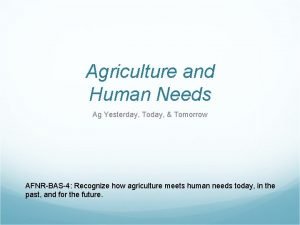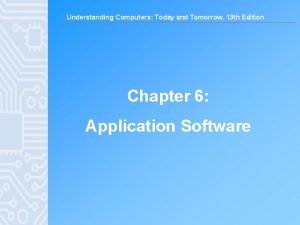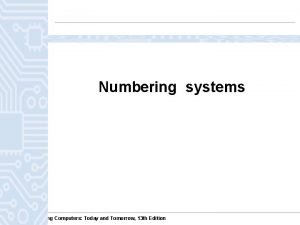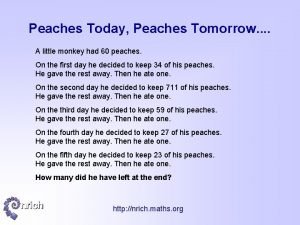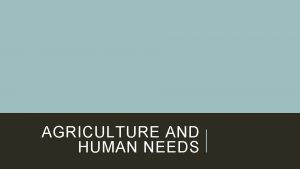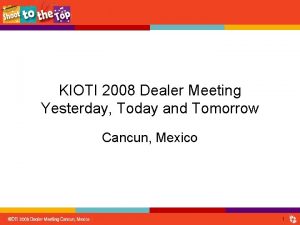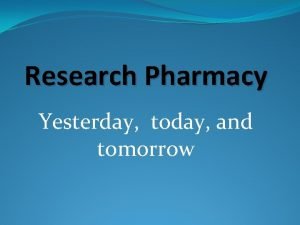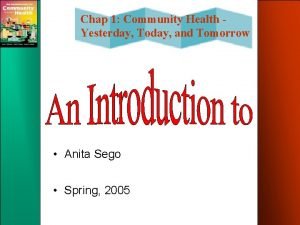Agriculture and Human Needs Ag Yesterday Today Tomorrow



















- Slides: 19

Agriculture and Human Needs Ag Yesterday, Today, & Tomorrow AFNR-BAS-4: Recognize how agriculture meets human needs today, in the past, and for the future.

Basic Human Needs and Sources agriculture is the source for the three basic things humans need to survive: 1. Food: meat, milk, eggs, fruit, vegetables, oil, butter, etc. 2. Clothing: leather, cotton, wool, silk, even synthetics 3. Shelter: lumber, plastics, insulation, carpeting We also get medicines, household items, and some forms of fuel/energy from agriculture. www. One. Less. Thing. net 2

Agriculture is… Agriculture is the science and management of the natural organisms that produce food, fiber, and other resources for human use. includes the study of growing, managing, and harvesting of plants and animals for use by people an industry that includes not only production, but also processing, marketing, distribution, marketing, sales, and services the largest industry in the U. S. employing over 20 million people www. One. Less. Thing. net 3

Major Areas of the Agriculture Industry Agronomy: the science and technology of producing and using plants for food, fuel, fiber, and land reclamation (a. k. a. crop production and research) Horticulture: the art and science of plant cultivation and management Animal Production: the study of the biology and management of domesticated animals for human use Aquaculture: raising aquatic species for food and other purposes www. One. Less. Thing. net 4

Major Areas of the Agriculture Industry Agriculture Mechanics: the development and maintenance of equipment and machinery for agricultural use Forestry and Natural Resources: the cultivation and conservation of forests, wildlife, and other natural resources Soil Science: the study of soil and land management as it relates to use by humans Agriscience and Biotechnology: research and innovation in methods to improve the efficiency, quality, and usefulness of agricultural products www. One. Less. Thing. net 5

Georgia’s Top 10 Agricultural Commodities commodity: a raw material or primary agricultural product that can be bought and sold www. One. Less. Thing. net 6

2015 Rank Commodity Farm Gate Value % of GA Total 1 Broilers $4, 428, 452, 093 32. 00 % 2 Eggs $937, 050, 097 6. 77% 3 Beef $923, 359, 237 6. 67% 4 Cotton $713, 144, 293 5. 15% 5 Peanuts $684, 626, 931 4. 95% 6 Timber $681, 237, 748 4. 92% 7 Greenhouse $428, 051, 228 3. 09% 8 Dairy $407, 721, 765 2. 95% 9 Pecans $361, 301, 753 2. 61% 10 Horses $280, 366, 400 2. 03%


Imports vs. Exports import: a commodity that is purchased from another country and shipped to the U. S. All U. S. agricultural imports have continued to grow since 1990. By far the largest U. S. agricultural imports are horticultural products, which have accounted for about half of all U. S. agricultural imports since 2002. U. S. consumers benefit from imports because imports expand food variety, stabilize year-round supplies of fresh fruits and vegetables, and moderate increases in food prices. Import examples: fruits, nuts, vegetables, nursery products, sugar, coffee, cocoa. Primary countries for imports: Canada, Mexico, and Brazil www. One. Less. Thing. net 9

Imports vs. Exports export: a commodity that is grown in the U. S. but shipped to another country U. S. agricultural exports have been larger than U. S. agricultural imports since 1960, generating a surplus in U. S. agricultural trade. Export examples: bulk commodities such as wheat, corn, cotton, soybeans, and tobacco; as well as highvalue products (HVP) such as meats, poultry, live animals, vegetable oils, fruits, vegetables www. One. Less. Thing. net 10

Products vs. Byproducts product: something that is produced as the primary substance that will be sold or processed and then sold examples: meat, milk, eggs, wool, hay, corn, soybeans, cotton, honey, peanuts, timber, flowers byproduct: something that is made during the production or manufacture of something else and therefore is the secondary product examples: leather, down, vegetable oil, beeswax, glue, mulch www. One. Less. Thing. net 11

Advantages of American Agriculture ideal climate rich soils developed transportation system advancement in technology and innovation The success and wealth of the United States can be tied to the strength of our agriculture industry.

A Better Product at Lower Cost American people have cheaper and safer food than any other people around the globe. Americans spend only 7. 1% of their yearly income for food. In other countries, people can spend up to 50% of their annual income on food alone.

Got Food? Thank a Farmer One American farmer produces enough food to feed 155 people. Since American farmers can efficiently feed so many people, other citizens are able to work in many different jobs. If farmers were not able to produce large amounts of food, everyone would be responsible for growing or gathering their own food.

Plants and Their Many Uses 1. Food: plants are our main source of food and processed ingredients for us and for the animals we eat and use 2. Fiber: plant fibers are used for clothing and other products (such as paper and packaging) 3. Shelter: most of the trees harvested for wood have been planted and maintained by tree farmers 4. Medicine: many plants are used in the manufacturing of medicine; for example the heart drug Digitalis is made from Foxglove

Everyday Uses for Animals 1. Food: most of the animals produced in the U. S. are raised for food 2. Clothing: hides are used for leather and the wool from sheep and goats is spun into yarn 3. Household Items: most are made from animal by-products, from detergents to candles to plastics 4. Medicine and Research: animals and animal by-products are used in the manufacture of medicines and new remedies are developed through research

Food Products From Animals ◦ Beef cattle: steaks, hamburger, roasts, and other meat products ◦ Dairy cattle: fluid milk for drinking and the production of cheese, butter, yogurt, ice cream, and other dairy products ◦ Pigs: meat (pork) such as ham, sausage, bacon, ribs, and pork chops. ◦ Poultry Industry: meat and eggs from chickens, turkeys, ducks, and other poultry animals ◦ Sheep and Goats: meat and milk (The meat from sheep is called lamb or mutton. ) ◦ Aquaculture: fish, shellfish, and other aquatic animals are grown on farms

Medicines From Animals Insulin for diabetics is made from a chemical produced by the pancreas in swine and beef animals. Pig skin is used in skin grafts for burn victims. Milk proteins help make bandaids stick. Research is also being performed on transplants from pigs to humans.

Thank you for learning with One Less Thing. “We make teaching Ag easier. ”
 Agriculture- yesterday today and tomorrow
Agriculture- yesterday today and tomorrow Tomorrow and tomorrow creeps in this petty pace
Tomorrow and tomorrow creeps in this petty pace Tomorrow and tomorrow and tomorrow kurt vonnegut analysis
Tomorrow and tomorrow and tomorrow kurt vonnegut analysis Royal family yesterday today is tomorrow
Royal family yesterday today is tomorrow Due tomorrow do tomorrow
Due tomorrow do tomorrow Due tomorrow do tomorrow
Due tomorrow do tomorrow How you use ict today and how you will use it tomorrow
How you use ict today and how you will use it tomorrow Computer today and tomorrow presentation
Computer today and tomorrow presentation Repeated subtraction example
Repeated subtraction example Understanding computers today and tomorrow
Understanding computers today and tomorrow Same today tomorrow and forever
Same today tomorrow and forever Marketing today and tomorrow chapter 1
Marketing today and tomorrow chapter 1 Who am i that the lord of all the earth
Who am i that the lord of all the earth Chapter 8 human needs and human development
Chapter 8 human needs and human development Chapter 8 human needs and human development
Chapter 8 human needs and human development 2moviego
2moviego Yesterday was a history tomorrow's a mystery
Yesterday was a history tomorrow's a mystery Tomorrow needs us song
Tomorrow needs us song Peaches today peaches tomorrow answers
Peaches today peaches tomorrow answers Learn today lead tomorrow
Learn today lead tomorrow
